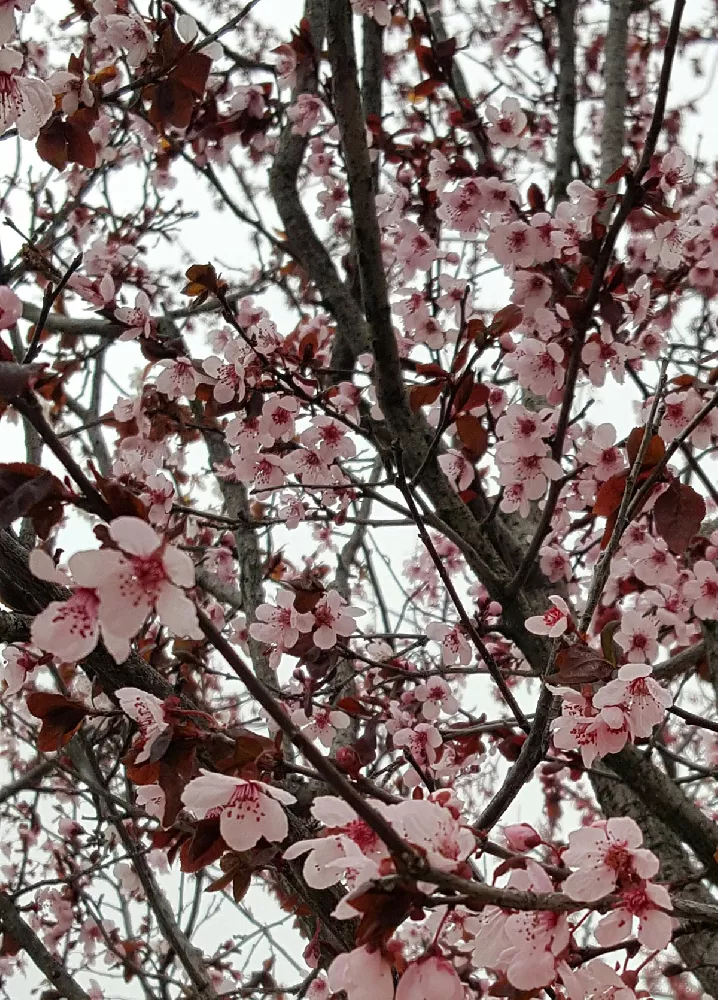Newport Plum for Sale - Buying & Growing Guide
- Ships in 1-2 days
- 1-Year Warranty Eligible
- Pots or accessories are not included unless specified in the product options.
Shipping Details:
Once your order is shipped, you’ll receive an email with a tracking number and estimated delivery date. Most orders ship immediately, but some items are seasonal and may only ship in spring or fall. These products are noted on the website.
There is no lack of ornamental flowering trees on the market, but if you are looking for a particularly elegant specimen, look no further than the Newport flowering plum tree. Prunus cerasifera 'Newport' is a moderate-sized tree that offers brilliant color throughout the growing season. In spring, the tree explodes with fragrant, white-pink flowers that lead to small fruits beloved by birds. But the show doesn't stop there. The tree's leaves are bronze in spring and early summer, deepening to a rich, dark purple throughout the summer. The Newport plum tree is a hardy tree that grows easily throughout much of the U.S. and is easy to care for as well. Here are a few more reasons to consider adding a Newport plum tree to your garden:
- The Newport plum tree adapts well to just about any type of soil: clay, loam, or sandy.
- It may be pruned to fit in a container for growing on a patio.
- It is hardy down to -30 degrees Fahrenheit.
Plant Care
Sunlight

The Newport plum tree grows best when it has full sun; six hours or more of direct light each day.
Watering
Your Newport plum tree will appreciate about an inch of water a week, either from rain or supplemental watering.
Fertilizing

Fertilize your Newport plum tree with a balanced, slow-release formula, such as a 5-5-5, in spring before bud break.
Planting and Care
Planting instructions
Site your Newport plum tree in soil that drains well and receives at least six hours of sun a day. Unpot the sapling and tease out any encircling roots, which can girdle the tree and slowly kill it. Dig a hole that’s as deep as the root ball and twice as wide. Throw a few handfuls of well-rotted manure or compost in the hole and place the tree on top. Holding the tree upright and steady, fill in around it with topsoil, tamping down as you go to eliminate air pockets. Water thoroughly. Apply a 2- to 3-inch layer of an organic mulch, such as bark chips, around the root zone to conserve moisture and hinder weed growth.
Watering and nutrients
When newly planted, water your tree every other day until you start to see robust new growth on the branches. Then scale back to once or twice a week, depending on weather. If it’s very hot or dry, give it additional water. A mature tree needs about an inch of water a week, either from rain or supplemental watering. Fertilize your tree in the spring with a balanced, slow-release formula designed for landscape trees and shrubs.
Pollination
Newport plum trees are a favorite tree for insects, such as mason bees and several varieties of butterfly that flock to the tree when it’s flowering. They do the work of pollination, which results in small, 1-inch plums that are not generally eaten because they’re rather bitter. This does not deter the birds and other wildlife, which enjoy the fruit immensely.
Pruning
Trim your Newport plum tree to shape it and for maintenance in the late winter, before new spring growth appears. The tree naturally forms a pleasing, rounded canopy and shouldn’t need much trimming. Monitor your tree for dead, broken, or diseased branches throughout the year, and cut them out when you see them. Also prune back any suckers that grow from the base of the trunk.
Pests, diseases, and animals
The Newport plum tree is susceptible to aphids, mealybugs, and various types of borer. Keep the base of your tree free of debris and leaf litter, and prune out any branches that are harboring infestations. Some pests can be handled by releasing predatory insects such as ladybugs, which feed on aphids. Diseases of the Newport Plum include leaf spot and canker. Deer are not attracted to these trees, but smaller animals such as squirrels may be drawn to the fruit.
Achieving maximum results
If you wish to grow your Newport Plum in a container, choose a pot that is roughly twice the size of the root ball. Fill it with a good-quality potting mix, and plant your sapling as per our directions above. Your tree can be pruned to remain smaller than its usual 20- to 30-foot mature height by doing some judicious annual pruning of the top and sides, cutting branches back to the collar of the adjoining branch. Your container-grown tree may need more supplemental water, especially if conditions are very dry, and will need regular fertilizing during the growing season.
FAQs
Where can you grow Newport plum trees?
What's the best use of a Newport plum tree in a landscape?
The Newport plum tree is an excellent specimen tree, holding its own, for example, as a stand-alone tree gracing a front yard. But it has other uses, too. Consider planting one as a central focal point in an Asian-inspired garden. Or plant two to flank a driveway, front walkway, or patio entrance. They can even work as an informal hedge or windbreak.
How close can I plant a Newport plum tree to my home?
Although the Newport plum tree works as a foundation planting, be sure to give it some elbow room so that it can grow to its mature width of roughly 20 to 25 feet. Because of that, you should plant it at least 10 feet away from any structures or other, taller trees.
Compare Similar Products
Customer Reviews
 Newport Flowering Plum
Newport Flowering PlumI fell in love with this plant online. It arrived with a few leaves but I wasn't worried because most of the reviews stated their plants had few leaves. Now it seems as though it's not getting Any new leaves. I am not sure if it's because I am in Florida. I am hoping it does well and will update this review later.
You can't add more Product Name - Product size to the cart.
OK






